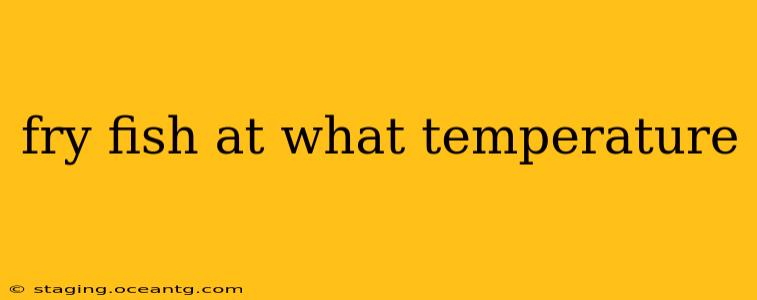Frying fish is a delicious and relatively quick way to prepare a healthy meal, but getting that perfect crispy exterior and flaky interior requires understanding the ideal temperature. Simply throwing fish into hot oil won't guarantee success; the temperature needs to be just right to prevent burning or leaving your fish soggy. This guide will explore the optimal frying temperature for various fish types, alongside frequently asked questions to ensure you achieve crispy, flavorful perfection every time.
What is the Best Temperature to Fry Fish?
The ideal temperature for frying fish is generally between 350°F (175°C) and 375°F (190°C). This temperature range allows for even cooking, creating a crispy exterior while keeping the inside moist and flaky. Going too low will result in greasy, soggy fish, while exceeding the upper limit risks burning the outside before the inside is cooked through. Using a thermometer is crucial for accurate temperature control.
How do I know if my oil is hot enough?
There are a couple of ways to check if your oil has reached the optimal temperature:
- Use a thermometer: This is the most accurate method. Simply insert a deep-fry thermometer into the oil and wait until it reaches the desired temperature.
- Bread crumb test: Drop a small piece of breading into the oil. If it sizzles immediately and browns within 30-60 seconds, the oil is ready.
What type of oil is best for frying fish?
Choosing the right oil is as important as the temperature. High-smoke-point oils are ideal for frying, as they can withstand high temperatures without breaking down or producing harmful compounds. Good choices include:
- Vegetable oil: A widely available and affordable option with a high smoke point.
- Canola oil: Another popular choice with a high smoke point and neutral flavor.
- Peanut oil: Offers a slightly nutty flavor and a high smoke point.
What happens if I fry fish at too low a temperature?
Frying fish at too low a temperature (below 350°F/175°C) leads to several undesirable results:
- Greasy fish: The fish absorbs more oil, resulting in a greasy texture.
- Soggy fish: The fish won't crisp up properly, leaving it soggy and unappealing.
- Uneven cooking: The inside may remain undercooked while the outside is already cooked.
What happens if I fry fish at too high a temperature?
Conversely, frying fish at too high a temperature (above 375°F/190°C) causes:
- Burnt exterior: The outside of the fish burns before the inside is fully cooked.
- Tough fish: High heat can make the fish tough and dry.
- Uneven cooking: Similar to low temperatures, uneven cooking is likely.
How long should I fry fish?
Frying time depends heavily on the thickness and type of fish. Thicker cuts will require longer cooking times. It's best to use a meat thermometer to ensure the internal temperature reaches 145°F (63°C) for safe consumption. Generally, smaller fillets might only take a few minutes per side, while thicker portions could require 5-7 minutes or more.
Can I fry frozen fish?
While it's generally recommended to thaw fish before frying for better results, you can fry frozen fish. However, it will significantly increase the cooking time and may result in a less crispy exterior. Ensure the fish is fully cooked through by using a meat thermometer.
By following these guidelines and paying close attention to the temperature of your oil, you'll be well on your way to frying fish to crispy, flaky perfection every single time. Remember, a good quality thermometer is your best friend in this cooking endeavor!
